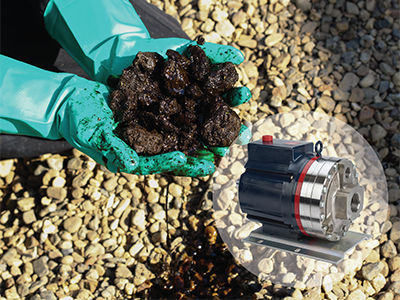
Application Story: Positive displacement pumps improve slurry transportation in oil sands pipeline
Mike Edwards
Features Hydra-Cell John Brooks Company slurry Wanner Engineering Slurries are abrasive, so the packing for the pumps requires continuous flushing
Slurries are abrasive, so the packing for the pumps requires continuous flushing An oil sands plant in Northeast Alberta uses massive pumps to move revenue-producing slurries in substantial volumes. Since the slurries are abrasive, the packing for the pumps requires continuous flushing.
Given the high-pressure requirements for this application, the customer fed water to the flushing points using multi-stage centrifugal pumps.
The plant has several massive slurry pumps in multiple locations, which require different duty points (often requiring entirely different flush pumps) to meet the plant’s flushing needs.
Some issues occur with changing process conditions affecting the duty points on the centrifugal pumps.
In some cases, the correct flow isn’t fed to the seals or glands, resulting in inadequate flushing and seal problems that require maintenance.
And often, the flow is on the low end of the centrifugal pump range, meaning they were running left on their curve and failing prematurely.
Existing pumps were expensive and often not interchangeable between different systems.
The pumps are critical to production, so virtually any downtime was detrimental, and with changing economic conditions, the customer needed to reduce costs and increase efficiency to keep operations viable.
THE SOLUTION
An application expert — Greg Beebe of John Brooks Company — offered Wanner Hydra-Cell D35 positive displacement pumps as an alternate solution to the plant customer’s flush pumps.
Flush water quality was critical to the success of the application and there was some concern that the water quality might cause issues in the future.
The water quality was closely monitored, and upstream strainers were considered in order to improve water quality before the flush.
TECHNOLOGY UTILIZED
- Wanner Hydra-Cell D35 pumps offer:
- Max. Flow Rate: 36.5 gpm (138 L/min) .
- Max. Discharge Pressure: 1500 psi (103 bar) .
- Max. Inlet Pressure: 250 psi (17 bar) .
- Max. Solids Size: 800 .m .
- Operational Efficiency
- Dry Run Capability
- Tolerates Tough Operating Conditions
- No Mechanical Seals, Packing or Cups to Leak or Replace
- Simple Compact Design
HOW POSITIVE DISPLACEMENT PUMPS WORK
As with any hydraulically driven diaphragm pump, oil moves the diaphragm forward to push water out of the liquid chambers.
A set of spring-loaded check valves prevent reverse flow, so a consistent forward flow is continues based on pump speed. Pressure is not a concern because changing pressure conditions don’t affect flow but instead change the motor’s amp draw.
The pumps can handle higher pressure than the processing system can produce, so there is very little chance of overloading the Hydra-Cell.
John Brooks offered the plant customer a Hydra-Cell trial pump with its system and to-date, due to the solids handling capabilities of the Hydra-Cell pump, quality concerns are not an issue.
THE RESULTS
The customer noted an overall improvement in the maintainability and efficiency of their system.
Additionally, John Brooks offered on-site training for the customer and provided technical support to ensure ongoing, long-term success with the pump solution.
This application story was contributed by John Brooks Company.
Print this page